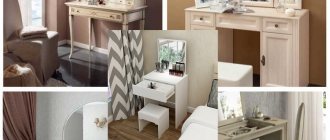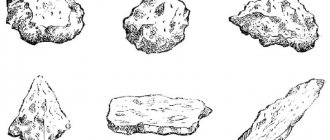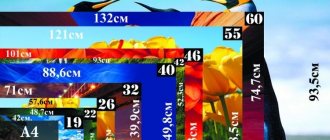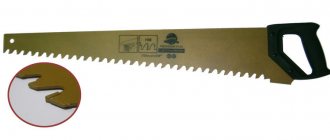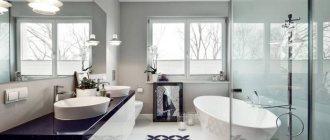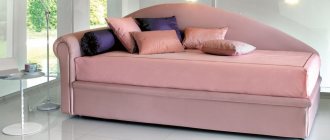In this article I will talk about what types of bathtubs are in greatest demand. I will write what they are made of, the pros and cons, and list the standard sizes of bathtubs. I will consider what types of bathtubs are equipped with hydromassage, and describe the shapes of the fonts.
The best way to relax after work is to take a hot bath with fragrant foam and turn on pleasant music. In markets and hardware stores, models from any material and various configurations are presented, so that the size and price are suitable even for small bathrooms.
Advantages and disadvantages of baths
Among the advantages of the units are noted:
- the opportunity to dive into the water and relax;
- the presence of built-in water massage in modern models.
Disadvantages include:
- bulkiness;
- consumption of large amounts of water.
The properties of the materials from which bathtubs are made are different, and these differences affect performance
Acrylic bathtubs - choose wisely
When choosing acrylic bathtubs, the following characteristics play a role:
The simpler the shape of an acrylic bathtub, the longer it will last
1. The thickness of the bathtub is 5-6 mm for the strongest ones. In other words, the best acrylic bathtub is the thickest one.
2. Product price. If it is suspiciously small - below 10 thousand rubles, you may run into ordinary plastic, which is covered with a thin layer of acrylic on top
Which bathtub manufacturer is better to choose? Find the answer in the article “Acrylic bathtubs: which manufacturer is better?”
Which bathtub is the best according to consumers? find out the answer here:
Read more about the advantages and disadvantages of metal bathtubs in the section of our website dedicated to this type of product
3. Is there a glossy shine - real acrylic bathtubs shine
4. Flexibility of the bathtub - only a plastic bathtub can bend. Real acrylic will withstand both 100 and 150 kg without flinching
The better the bathtub is reinforced, the more reliable it will be
5. The number of layers of reinforcement (they are sprayed from a cannon onto the outside of the bathtub - after the workpiece has cooled) - they can be easily counted if you look at the side of the bathtub
6. The form – the simpler, the more reliable. After all, non-standard bathtubs are easier to blow from thinner acrylic, and this is fraught
Classification
Bathtubs are classified according to materials of manufacture, size and configuration. The sum of these characteristics determines the price of the washing device.
Material:
There are:
- cast iron;
- acrylic;
- metal;
- from cast marble.
Cast iron
In apartments built in Soviet times, cast iron monsters are still preserved, the service life of which is half a century.
Advantages:
- exceptional reliability;
- keeps warm (cast iron model takes a long time to cool down).
The disadvantages include:
- high cost;
- heavy weight;
- limited choice of shapes and sizes;
- scratches form on the enamel covering the surface over time;
- the sound of falling water is heard.
Cast iron has a high mass, which is explained by the properties of the material, low thermal conductivity, and high strength
Acrylic
Acrylic bathtubs appeared on the construction market relatively recently, but due to their qualities they are popular with buyers.
Their advantages:
- light weight, which facilitates transportation and installation;
- the ability to create structures of various sizes and shapes;
- long-term heat retention;
- possibility of installing underwater massage;
- long service life;
- ease of washing.
- When water falls from a height, it does not crash against the bottom of the bathtub.
The main advantage of acrylic is that various models of bathtubs of the most intricate shapes are made from it
. Disadvantages:
- less durable than cast iron, they can break when hit by a heavy object;
- can only be washed with a soft sponge and soap or special products for acrylic models;
- some models require an additional frame.
Small scratches on the surface can be easily repaired with special materials
Signs that should not be purchased:
- strong unpleasant odor;
- surface roughness;
- the product has many broken lines.
Steel
Compared to cast iron products, they benefit from several characteristics:
- less weight;
- ease of installation;
- lower price.
Sanitary containers made of steel are quite light in weight, which is 3-5 times less than that of cast iron
. Disadvantages:
- cools down quickly;
- The water hits the bottom very noisily.
Cast marble
Cast marble is a material made from marble chips glued together with polyester resins.
Advantages of the model:
- holds heat well;
- withstands heavy loads;
- can be painted in a variety of colors;
- looks beautiful.
Bathtub made of cast marble
Disadvantages:
- heavy weight;
- complexity of transportation and installation;
- high price.
There are also models made of wood. Wooden ones look exclusive and luxurious. A cast bathtub can be decorated with mosaics.
You rarely see wooden ones, but their appearance makes the design of the room unique.
They occupy a special place.
Unique wooden bathtub
Types of baths
Today's bathtub market is represented by a huge assortment. Bathtubs vary in type of material, size, shape, color and manufacturer.
Bathtub sizes
Baths have several standards that determine the parameters. The dimensions of the bathtub are important so that you do not encounter any problems during installation and operation. Size is especially important for small bathrooms. If your renovation has not yet begun, and there are only bare walls in the bathroom, choose a bath with a reserve: the tiles will eat, on average, 2 centimeters of each wall.
In terms of length, bathrooms come in standard sizes from 150 to 180 cm, and non-standard ones - from 2 meters. The usual width of the bathtub ranges from 75 to 100 cm; non-standard sizes are also available. The standard bathtub depth is 65 cm; there are smaller and deeper options. To choose the perfect bath, you need to take into account the height and build of all family members. Agree that you won’t be able to completely relax in a bathtub with your knees sticking out.
Remember that the gap between the wall and the side should not be more than 3 mm. Then it can be easily covered with construction sealant or special tape. A large gap can be closed with waterproof gypsum board and tiled.
Types of bathtubs by material of manufacture
Modern conditions and technologies make it possible to produce bathtubs not only from traditional materials (cast iron, steel and acrylic), but also from wood, stone or glass.
Cast iron bath
The most popular material. It is durable and strong. The service life of such a bath is up to 25 years. A special feature is its high heat capacity.
Enamel is most resistant to damage such as scratches and corrosion. But even with a damaged coating, the bathtub will still last a decent amount of time.
Another advantage of the bath is its ease of maintenance.
One of the disadvantages of a cast iron bathtub is its heavy weight (some models reach 150 kg) and difficulty in lifting to high floors and during installation. The price of this type of bathtub is quite high. However, the design is not very diverse.
The most famous manufacturers of these bathtubs are the Russian and Spanish companies Roca and the French company Jacob Delafon.
Steel bath
Bathtubs are made from two types of steel: stainless and structural. Structural steel looks very similar to cast iron. The maximum thickness is almost 5 mm, and the minimum is 2.5 mm. Acrylic enamel is used as enamel. This type of bathtub is highly accessible due to its low prices.
Such bathtubs are quite lightweight and easy to transport and install. A standard steel bathtub with a thickness of 3 mm weighs about 30 kg. There is also a large selection in terms of design solutions. The disadvantages are high noise level and low heat capacity. There are a number of ways to help reduce noise levels.
Stainless steel is less common as a bathtub material, perhaps due to its high price. A stainless steel bathtub is not enameled.
Ways to reduce the noise level of a steel bathtub
Method 1. Rubber or sheet rubber must be glued to the bottom of the bath on the back side; you can also use Penofol and its analogues.
Method 2. Before installing the bathtub, a layer of polyurethane foam is applied to the outer area (on the walls and the bowl itself), which will insulate sound.
Well-known manufacturers of steel baths: the German company Bette, Estap - Slovakia and the BLB company from Portugal, domestic companies - Verkh-Isetsky Metallurgical Plant and Lipetsk Pipe Plant.
Acrylic bath
The peculiarity of these types of baths is that they are very easy to clean. They also have high thermal insulation. The material allows you to give the bath a variety of shapes, while the weight will be low (up to 25 kg).
When purchasing an acrylic bathtub, you need to learn as much as possible about the manufacturer and the technology for creating the bathtub, because... if during production money is saved on raw materials and processing, then at a minimum the bathtub will have an unpleasant odor, and at maximum it will have a very short service life and possible leaks. As a rule, a good bathtub has a thickness of more than 5 mm. However, many stores sell restoration kits. Professionals are conditionally divided into two categories: some support and advise the use of restoration kits for minor damage. Others, on the contrary, recommend changing the bath immediately.
Some manufacturers install a covering made of sanitary acrylic, this prevents the growth of germs, bacteria and fungi.
Manufacturers of acrylic bathtubs: BelBagno, Jacuzzi and Cezares - Italy, Ravak and Riho - Czech Republic, Cersanit and Kolo - Poland, Villeroy&Boch and Duravit - Germany, Roca and Pool Spa - Spain and others; Aquanet can be distinguished among domestic manufacturers.
Quaryl baths
A new product on the plumbing market, presented by the German company Villeroy & Boch AG. These are bathtubs made from a mixture of acrylic and quartz. Quartz has a high level of strength, and when mixed with acrylic, such a bathtub does not need reinforcement. Strength and impact resistance are the main features of quaril baths. The thickness of the bath is about 10 mm. Also, some models of such bathtubs do not require a metal frame. Of course, the weight of this type of bathtub is greater than acrylic and steel, but less than cast iron. The disadvantage of this type is the relatively high cost: in the Perfecto online store you can buy a quaril bath at a price of 35,000 rubles.
Ceramic baths
This type of bathtub is divided into 2 groups according to the manufacturing method: metal-ceramic and earthenware.
Earthenware bathtubs have the highest cost: they are made from noble varieties of white clay, and a layer of acrylic glaze is applied on top.
The metal-ceramic type of bathtubs consists of a metal frame covered in alumina. The main difference from earthenware bathtubs is their lighter weight and thinner walls. Ceramic metal is not as expensive as earthenware due to the low consumption of white clay.
The advantage of ceramic baths is that they maintain the temperature for quite a long time, lack of noise and durability. But you need to remember to be careful when using it, because... bathtubs are prone to cracks and chips.
Ceramic bathtubs, as a rule, have an oval shape. They can be of different colors: from white to coffee. Standard sizes: length from 130 to 170 cm, width from 65 to 75 cm.
On the Russian market, this type of bathtub is represented by the companies Santek and TM Colombo, as well as by the Italian manufacturers Flaminia and Globo.
Baths with various additions
The shapes of bathtubs are very diverse and square, oval or asymmetrical bathtubs are less and less surprising. For convenience, manufacturers began to add a variety of handles, buttons, lighting, and other elements and functions to bathtubs.
There were baths designed not only for one person. In different models you can relax, sitting next to or opposite each other.
An automatic disinfection system can be installed. After each bath, the system delivers a disinfectant and then rinses it off.
The variety of shapes is also emphasized by the color options. Now you can choose a bathtub to match the color scheme of the walls. And big music fans can even purchase a bathtub with color music.
The most diverse and popular are baths with hydro and air massage. Massage in such baths is carried out thanks to directed jets of water and air. Most massage bathtubs are made from acrylic, which is easy to install jets into.
When choosing such a bath, the power of the pump will be important. Typically, 250 liters require 1 kW. If the bath is larger, then the pump must be selected with a higher power.
You also need to pay attention to the injectors. If there are few of them, then the water massage will be stronger. It is quite comfortable when the number of nozzles is 15 – 20 pieces.
A modern addition to the Jacuzzi is a water level sensor. It determines the level of fullness of the bath and will not allow you to turn on the hydro or air massage if there is no water in the font.
In steel and cast iron bathtubs, the use of additional functions is almost impossible.
Wall and corner baths
Wall-mounted bathtubs can be installed both at a distance from the walls and close to them. The most popular shape of wall-mounted bathtubs is oval, but there are other shapes (circle, figure eight, ellipse and asymmetrical shapes).
Corner ones must be installed in one of the corners of the room. The shape of such bathtubs is usually a quarter circle with regular geometry. Sometimes you can find asymmetrical fonts.
Dimensions and dimensions
Regular rectangular ones are available in standard sizes:
- length – 180, 170, 150, 130, 120 cm;
- width – 80, 75, 60 cm;
- height – 62.65 cm.
If possible, you should select a model that matches the height of the tallest member of the family, otherwise he will have to accept it with his knees bent.
Currently, many new models are being released with sizes that differ from the standard ones.
The dimensions should be comfortable for all residents of the house, and also correspond to the space of the bathroom
Choosing the right steel bathtub is especially important
After all, they themselves are not particularly durable. Which steel bathtub is better?
Steel bathtubs value correct geometry and smooth surface
Firstly, made of steel 3.5-4 mm thick. Of course, measuring it in a store is problematic. But let’s be smart: you can lift the bath a little or move it from its place. If it’s heavy (a high-quality steel bathtub weighs about 20 kg), then it has the right thickness.
You won’t be able to measure the enamel layer yourself either. But know that 2 mm is better than 1.
Secondly, you need to check the steel bath for sound. Does it make a smooth sound when tapped?
Then everything is fine. If the bathtub is “out of tune” - there are strange noises and rattling - the steel is of poor quality.
And one more thing - a steel bathtub, like an acrylic one, must have ideal geometry and a smooth, smudge-free surface.
Variety of shapes
The construction market offers any form.
This and:
- ordinary rectangular;
- oval;
- round;
- square;
- corner;
- broken lines of various configurations.
Corner mini-bath is the ideal solution for a small bathroom
Specifications
The advantage of acrylic models over other representatives of bathroom products is the ability to install hydromassage in them. They have many nozzles in the bottom and sides, through which water and air are supplied under pressure into the filled bathtub and massage the person in it.
There are 2 types:
- with hydromassage nozzles;
- with hydromassage and air massage nozzles.
Such options are installed in spacious rooms that allow the placement of additional devices (compressor, water and air mixer, etc.). As an option, suitable for a spacious attic.
A hydromassage is a device equipped with a special system that creates constant movement of water inside the bowl.
Quaryl baths
Which floor is better to install in an apartment: tips and solutions
Quaril is a modern, technologically advanced material produced by combining functional acrylic and durable quartz. Quaril is used to produce exclusive, expensive bathtubs with excellent performance characteristics. Models made from this unique material are heavier and stronger than acrylic ones; they have low thermal conductivity, like cast iron. Quaril baths come in various shapes, colors and sizes and are produced to individual orders.
Quaril bath
The addition of quartz improves the following qualities of acrylic:
- Thermal conductivity. Models made from quaril are not inferior in thermal conductivity to cast iron bathtubs, which perfectly retain heat during use.
- Low noise. Adding quartz reduces the noise level when collecting water into a container made of this material.
- High temperature resistance. Models made from this material can be used at any water temperature without restrictions.
- Strength. Models made from quaril are highly durable; they do not crack or deform under intense load.
- Easy to maintain. The structure of this material repels dirt, so caring for it comes down to periodic disinfection and rinsing.
- Ease of installation. Higher mechanical strength allows you to install quaril baths without frame equipment.



